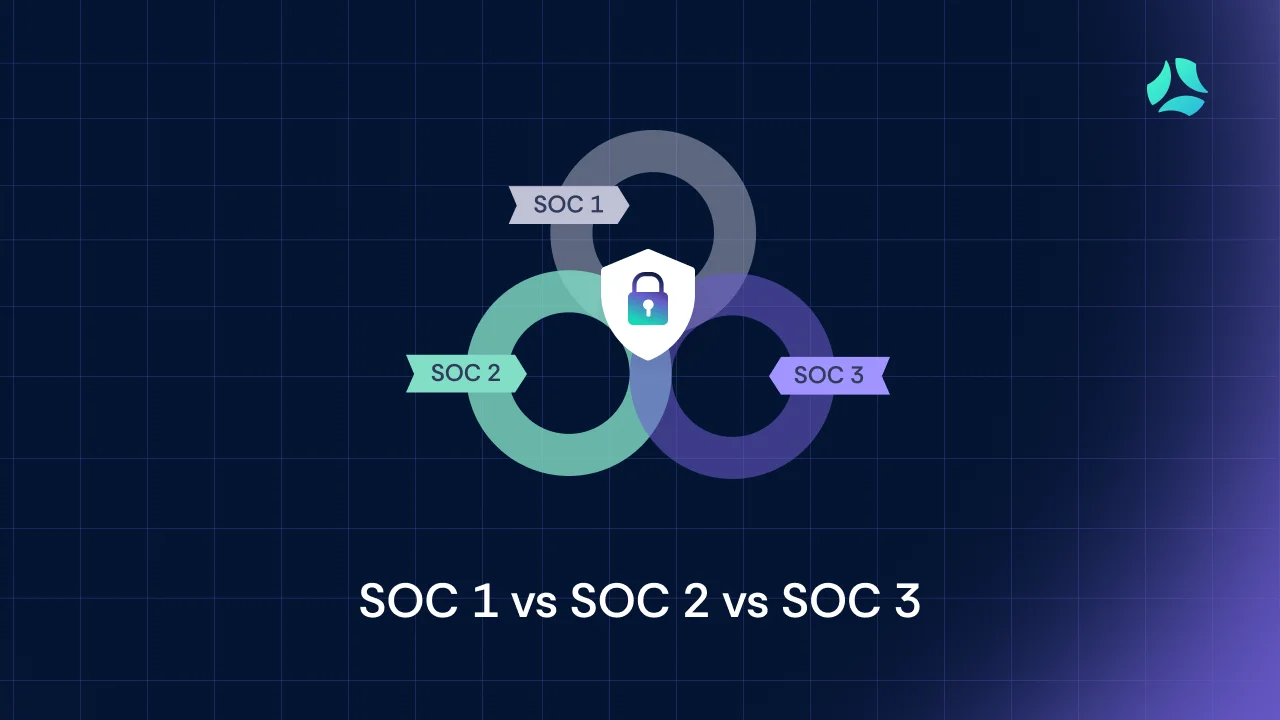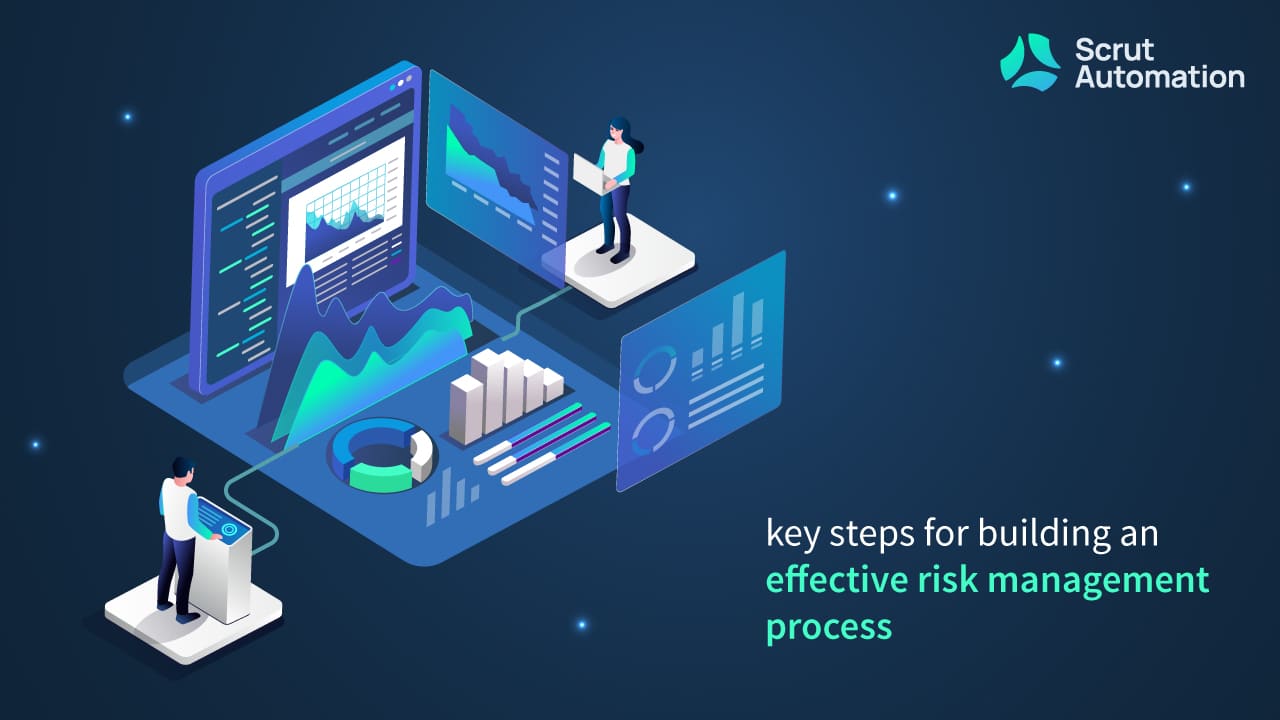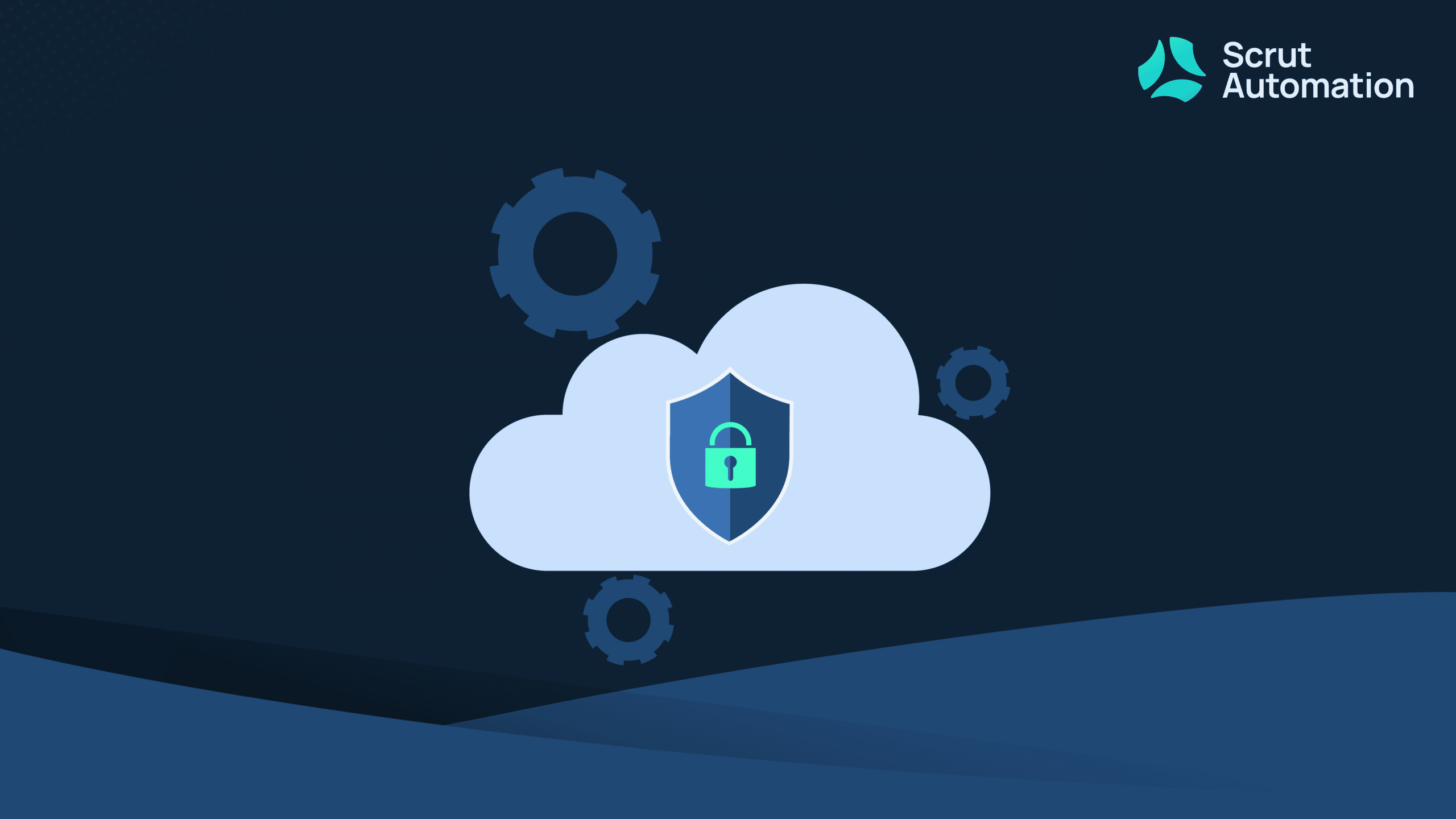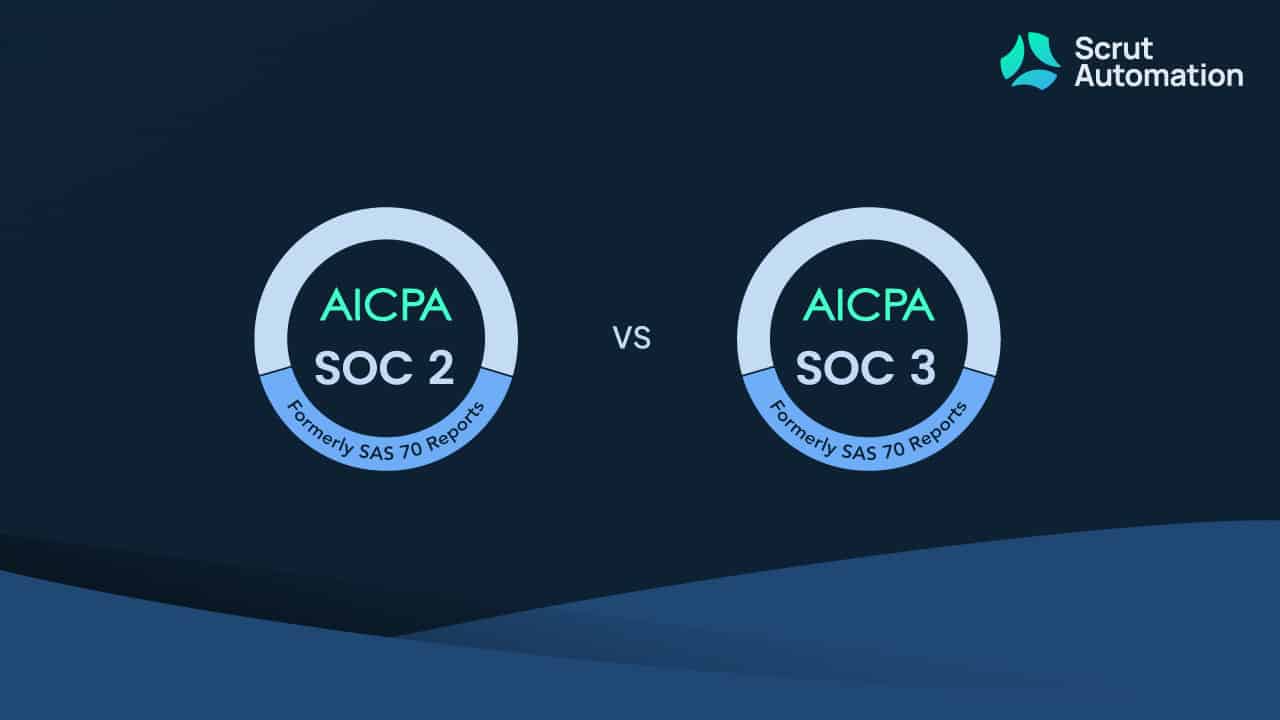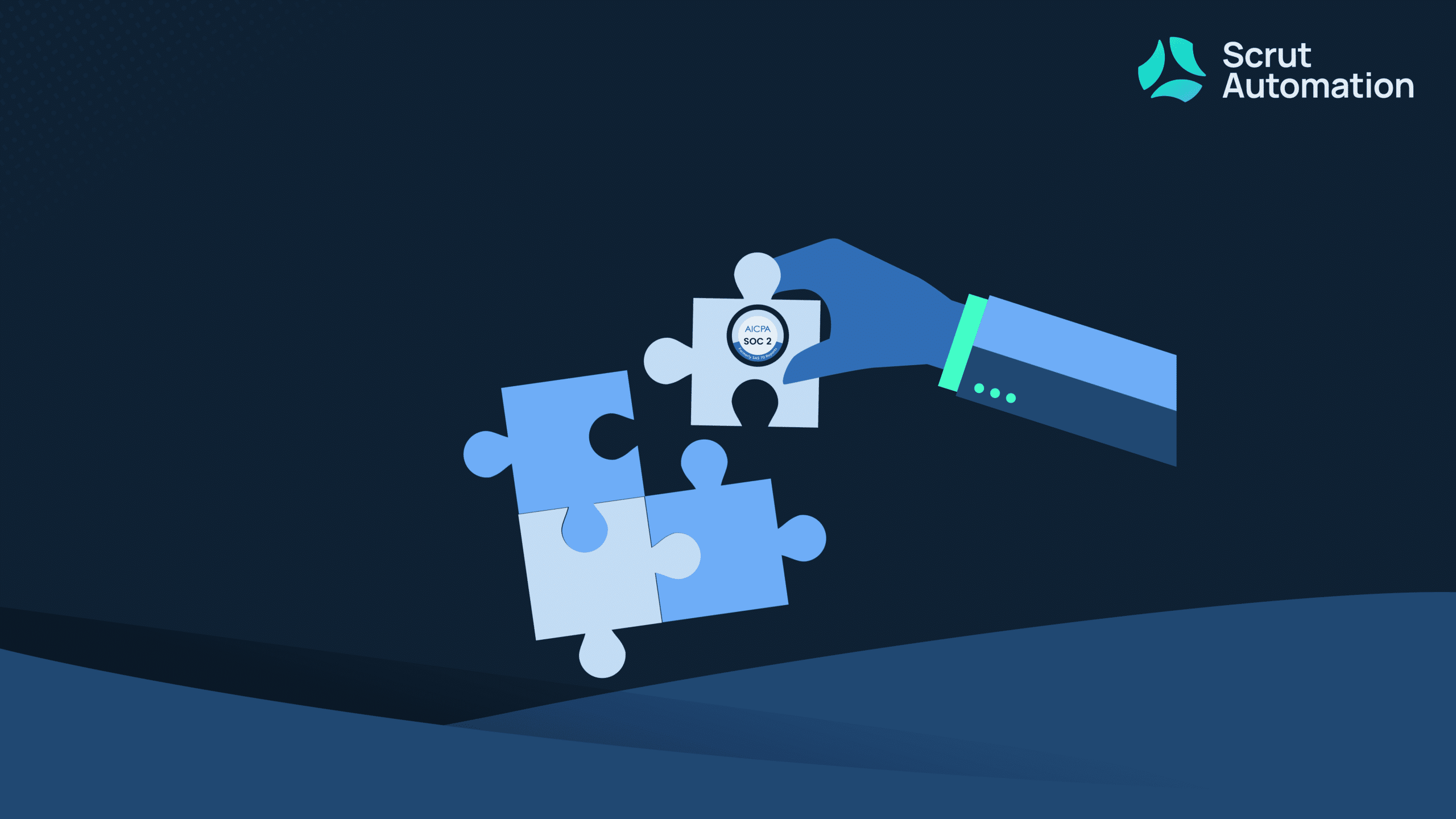
Grace Arundhati
SOC (System and Organization Controls) reports are essential for businesses that handle sensitive data. They provide assurance to clients and stakeholders about how these businesses manage and secure data.
There are three main types of SOC reports—SOC 1, SOC 2, and SOC 3—each designed for different purposes and audiences. SOC 1 focuses on internal controls over financial reporting, SOC 2 addresses security, availability, processing integrity, confidentiality, and privacy of systems, and SOC 3 is a public-facing summary of SOC 2 results.
Understanding the differences between these reports is key to helping businesses ensure their data management practices align with industry standards.
An Overview of Differences between SOC 1, SOC 2, SOC 3
| Feature | SOC 1 | SOC 2 | SOC 3 |
| Purpose | Assess controls over financial reporting | Evaluate controls related to security, availability, processing integrity, confidentiality, and privacy | Provide a public summary of SOC 2 findings |
| Audience | Primarily for auditors and financial stakeholders | Primarily for customers and business partners concerned with data security | General public, marketing tool for customers |
| Report type | Detailed report, not publicly available | Detailed report, restricted to specified users | High-level summary, publicly available |
| Trust Services Criteria | Not applicable | Based on Trust Services Criteria (Security, Availability, Processing Integrity, Confidentiality, Privacy) | Based on the same criteria as SOC 2 |
| Focus areas | Financial reporting controls | Security, availability, processing integrity, confidentiality, privacy | Summary of SOC 2 findings, with no detailed control descriptions |
| Frequency | Not mandatory, but generally performed annually | Not mandatory, but generally performed annually | Not mandatory, but generally performed annually |
| Level of detail | High, detailed with control descriptions | High, detailed with control descriptions | Low, overview of SOC 2 results |
| Use case | Used by financial auditors for financial reporting | Used by clients and business partners to assess the organization’s internal controls over data handling | Used for marketing and public assurance of SOC 2 compliance |
What is SOC 1?
SOC 1 (System and Organization Controls 1) is a framework designed to assess the controls at a service organization relevant to user entities’ financial reporting. It is typically used when third-party service providers like payroll services, IT outsourcing, or data centers impact client financial reporting.
SOC 1 reports evaluate the effectiveness of Internal Controls Over Financial Reporting (ICFR), ensuring that organizations manage financial processes securely and effectively. They are commonly used by clients and auditors to assess risks.
SOC 1 reports come in two types:
- SOC 1 Type 1 evaluates the design of financial reporting controls at a specific point in time.
- SOC 1 Type 2 assesses both the design and the operational effectiveness of controls over a period (typically 6 to 12 months).
SOC 1 reports are typically updated annually, though it is not a legal requirement to do so. While they are most commonly used in the U.S., SOC 1 reports are also gaining recognition globally in countries like Germany, Japan, Brazil, India, China, and Saudi Arabia.
The timeline for obtaining a SOC 1 report usually ranges from 2 to 3 months, and the costs typically range from $10,000 to $50,000 or more, depending on the audit’s size and complexity.
Who needs the SOC 1 report?
- Service organizations handling financial data such as payroll providers or accounting services.
- Banks, investment firms, and other financial organizations that rely on outsourced services to support financial operations.
- Cloud service providers with financial impact
- Businesses that provide outsourced services (e.g., IT services, data processing)
- Organizations required to demonstrate control over financial reporting processes.
- Companies undergoing financial audits
- Publicly traded companies
What are the requirements of SOC 1?
- Identification of key internal controls affecting financial reporting
- Documentation of control activities and processes
- Proper segregation of duties within the organization
- Regular risk assessments and audits to ensure control effectiveness
- Adherence to generally accepted accounting principles (GAAP)
- Clear communication and reporting mechanisms
- Independent third-party audits (from certified public accountants or auditors)
- Security protocols to ensure data protection during financial reporting processes
How to get the SOC 1 report?
- Engage a certified auditor or firm: Select a qualified auditor to assess your financial reporting controls and compliance.
- Define the scope of the audit: Determine the relevant financial reporting processes and controls to be evaluated.
- Prepare internal controls and documentation: Assess financial reporting processes, identify key controls, document existing procedures, and ensure proper segregation of duties.
- Undergo the SOC 1 audit: Work with the auditor to review and evaluate the effectiveness of the financial controls in place.
- Receive the SOC 1 report: After the audit, the auditor will provide a report detailing control effectiveness and areas for improvement.
- Maintain compliance: Continuously assess and refine financial controls to ensure ongoing compliance with SOC 1 requirements.
Advantages of SOC 1
- Provides third-party validation of financial reporting controls, enhancing trust with clients and stakeholders.
- Demonstrates compliance with financial regulations and industry best practices, which can be a competitive advantage.
- Helps businesses stay ahead of regulatory requirements, improving their ability to meet evolving compliance standards.
Disadvantages of SOC 1
- Focuses exclusively on financial reporting, not on other aspects like security or privacy.
- The audit process can be costly and time-consuming, especially for smaller organizations.
- SOC 1 does not assess the effectiveness of the overall security posture of the organization, meaning it may not provide assurance for areas outside financial reporting.
What is SOC 2?
SOC 2 (System and Organization Controls 2) is a security framework that assesses an organization’s controls over five Trust Services Criteria: security, availability, processing integrity, confidentiality, and privacy. It is designed for technology and cloud service providers that store or process customer data.
- SOC 2 Type 1 focuses on the design of controls related to these criteria at a specific point in time.
- SOC 2 Type 2 evaluates both the design and operational effectiveness of these controls over a defined period, ensuring they function effectively to manage data security and privacy risks.
SOC 2 provides assurance to clients and stakeholders that a company has adequate systems in place to secure sensitive information.
While not legally required, SOC 2 is highly valued by organizations wanting to demonstrate their commitment to data protection. Originally developed in the U.S., SOC 2 is now widely recognized globally, especially in regions with strict data privacy regulations.
SOC 2 reports are typically updated annually, and audits are generally repeated after a year. Obtaining a SOC 2 report takes 2 to 6 months, depending on the scope and internal readiness. Costs range from $15,000 to $75,000, with Type 2 audits typically being more expensive due to the longer evaluation period.
Who needs SOC 2?
SOC 2 is particularly relevant for organizations in the technology, cloud computing, and SaaS (Software as a Service) industries, as they handle large amounts of customer data.
- SaaS providers
- Cloud service providers
- Technology and IT companies
- Financial services companies
- Healthcare companies
- Companies with third-party relationships
- Regulated industries
What are the requirements of SOC 2?
- Security: Protection of systems and data against unauthorized access
- Availability: Ensuring systems are operational and accessible as agreed
- Processing Integrity: Accuracy and completeness of processing
- Confidentiality: Protection of confidential information from unauthorized access
- Privacy: Management of personal data in accordance with privacy regulations
- Risk management processes
- Regular internal and external audits
- Documented policies and procedures for data protection
- Secure communication channels for transferring data
- Staff training on security and privacy best practices
How to get SOC 2 Certified?
- Engage a certified auditor or firm: Select a qualified auditor to assess your organization’s controls against SOC 2 criteria.
- Define the scope of the audit: Identify the relevant Trust Services Criteria (security, availability, processing integrity, confidentiality, and privacy) to be evaluated.
- Prepare internal controls and documentation: Implement appropriate policies, procedures, and employee training to align with SOC 2 requirements.
- Undergo the SOC 2 audit: Work with the auditor to evaluate the design and operational effectiveness of your controls.
- Receive the SOC 2 report: After the audit, the auditor will generate a report detailing their findings on your control effectiveness.
- Maintain compliance: Conduct internal assessments and continuously improve your controls to ensure ongoing compliance with SOC 2 criteria.
Advantages of SOC 2
- Enhances customer trust by demonstrating a commitment to protecting sensitive data.
- Supports compliance with industry regulations and standards, such as GDPR or HIPAA.
- Attracts new business opportunities, helps differentiate your organization from competitors, and helps attract new clients who value security and privacy.
- Mitigates risk of data breaches, security incidents, and non-compliance penalties.
- Improves internal security processes by identifying and addressing weaknesses in your internal security and privacy controls.
- Strengthens your organization’s reputation, especially in industries where data security is a priority.
Disadvantages of SOC 2
- Lengthy and expensive particularly for small businesses.
- Does not focus on all security aspects; only focuses on a specific set of controls.
- Continuous maintenance required
- Implementation is complex and may require significant changes in processes and systems, particularly for smaller organizations.
- Resource-intensive: The time and resources required for preparing for the audit, maintaining compliance, and coordinating with auditors can strain internal teams, especially in smaller companies.
What is SOC 3?
SOC 3 (System and Organization Controls 3) is a public-facing report based on the same Trust Services Criteria as SOC 2. Unlike SOC 2, which provides a detailed audit of an organization’s controls, SOC 3 offers a summarized version intended for a broader audience.
SOC 3 demonstrates an organization’s commitment to data security and privacy in a simplified format. It is ideal for companies looking to publicly assure customers of their data protection practices. SOC 3 reports are typically updated annually. While there are no penalties for not completing it, companies may face reputational risks if they do not obtain it when customer confidence is crucial.
The process generally takes 2 to 4 months to complete, with costs ranging from $15,000 to $60,000, depending on the organization’s size and audit scope. SOC 3 audits are usually less expensive than SOC 2 due to the summarized nature of the report.
Who needs SOC 3?
- Industries like cloud computing, SaaS, and technology, where data security and privacy are crucial.
- Businesses in the U.S., Europe, and internationally, especially those working with customers in regulated industries.
- Useful for marketing, providing an easy-to-understand, public-facing report that assures customers about the organization’s controls.
- Important for companies looking to differentiate themselves in competitive markets by demonstrating adherence to security standards in a clear and accessible way.
What are the requirements of SOC 3?
- Security: Protect systems and data against unauthorized access
- Availability: Ensure systems are operational and available as agreed upon
- Processing Integrity: Ensure data processing is complete, valid, accurate, timely, and authorized
- Confidentiality: Protect confidential information from unauthorized access
- Privacy: Manage personal data in accordance with privacy regulations
- Regular audits and assessments
- Documentation of policies and procedures for managing security and data privacy
- Transparent reporting to customers about security practices
How to get SOC 3 Certified?
SOC 3 is often considered a simplified version of SOC 2.
- Go through the SOC 2 audit, as SOC 3 is based on its findings.
- Create a public-facing summary, highlighting the organization’s compliance with the Trust Services Criteria.
- Make the report available to the public (via the company’s website or other public-facing platforms) to demonstrate its commitment to security and data protection without revealing detailed control information.
Advantages of SOC 3
- Provides a publicly accessible summary of SOC 2 findings, helping to build trust with a broader audience.
- Allows for marketing the company’s commitment to security and data protection without revealing detailed internal controls.
- Helps organizations comply with customer expectations for data security assurance, especially in industries like technology and SaaS.
- Can be shared more easily with potential clients and partners as part of an outreach or business development strategy.
Disadvantages of SOC 3
- Lacks the detailed information present in the SOC 2 report, which some clients may need for deeper assurance.
- May not be sufficient for highly regulated industries or organizations that require more extensive security assessments.
- Does not provide the same level of depth in terms of internal controls, which may leave some stakeholders wanting more comprehensive information.
Which framework to choose for your company?
Choosing the right SOC framework for your company depends on the nature of your business, the type of data you handle, and the specific needs of your stakeholders.
While SOC 1 focuses on financial reporting controls, SOC 2 is geared toward organizations that manage sensitive data, particularly in terms of security, privacy, and operational integrity. SOC 3, being a public-facing summary of SOC 2, is ideal for companies looking to provide a high-level assurance to a broad audience without revealing detailed internal controls.
The decision should be based on what your clients and stakeholders prioritize—whether it’s financial reporting accuracy, data security, or public transparency.
How can Scrut help to automate the SOC 2 compliance process?
Scrut offers targeted solutions to automate and streamline compliance across various frameworks, helping businesses continuously assess, document, and maintain compliance with minimal manual effort and real-time insights.
By leveraging Scrut, organizations can:
- Automate documentation and evidence gathering: Scrut simplifies the process of creating, tracking, and maintaining essential compliance documentation, ensuring it is always up to date and audit-ready.
- Real-time monitoring: Scrut continuously monitors controls, ensuring that security configurations and policies are aligned with regulatory requirements, reducing the risk of non-compliance.
- Ongoing compliance tracking: The platform tracks compliance over time, ensuring operational effectiveness and helping organizations stay prepared for periodic audits.
- Audit-ready reports and evidence collection: Scrut automatically collects evidence and generates reports, eliminating the last-minute scramble for documentation and keeping businesses always audit-ready.
- Simplify audit management: Scrut offers an intuitive dashboard to manage audit tasks, track progress, and maintain relevant evidence in one central place.
With Scrut, businesses can automate routine compliance checks, enhance their security posture, and ensure seamless audit preparation, saving time while ensuring compliance remains on track. To learn more about how Scrut can help on your compliance journey, feel free to get in touch!
FAQs
Can I replace SOC 1 with SOC 2 or SOC 3?
No, SOC 1 cannot be replaced by SOC 2 or SOC 3. SOC 1 focuses specifically on financial reporting controls and is designed for organizations that impact client financial statements. SOC 2 and SOC 3, on the other hand, assess controls related to data security, availability, processing integrity, confidentiality, and privacy. While SOC 2 and SOC 3 share similar criteria, they do not address the financial reporting processes covered by SOC 1, so each serves a distinct purpose.
What are the similarities between SOC 1, SOC 2, and SOC 3?
- Trust services criteria: SOC 2 and SOC 3 both focus on the Trust Services Criteria (security, availability, processing integrity, confidentiality, and privacy), while SOC 1 may include some aspects of control relevant to these criteria but focuses mainly on financial reporting.
- External auditing: All three frameworks require an independent auditor to evaluate the effectiveness of the controls and generate a report.
- Third-party assurance: They all offer third-party assurance to clients and stakeholders regarding the organization’s control environment and effectiveness in managing risk.
